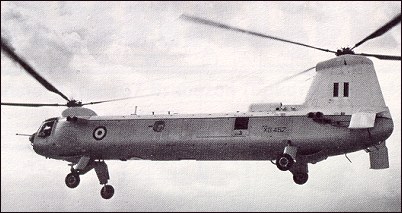
| Bristol Type 191/192 "Belvedere" 1952 |  |
 |

| Bristol Type 191/192 "Belvedere" 1952 |  |
 |
|
The Bristol 173 was the first helicopter specifically designed for commercial operation and passenger transport in particular. The first prototype, which flew on 3 January 1952, was powered by two 520hp Alvis Leonides engines and could carry ten passengers. The tandem rotors were identical to those of the Bristol 171 "Sycamore". Trials were carried out with this aircraft in 1953, from the aircraft carrier HMS Eagle. The second prototype was similar to the first but was modified to test the characteristics and effects of two stub wings and later a four-bladed rotor. The Bristol 173 Mk.3, of which three were built, with capacity increased to 16 seats and Alvis Leonides Major engines, was offered to BEA. Unfortunately, none of these aircraft succeeded in overcoming a series of developmental problems and subsequent projects undertaken by Bristol — models 191 and 193 — in response to Royal Navy and Canadian naval specifications were no more successful. However the Type 192, the prototype of which flew on 5 July 1958, was adopted by the RAF. In the initial configuration, this aircraft had a purely manual system of control and wooden rotor blades but power controls and metal blades were standardized on the fifth prototype built in 1960. That year, three pre-production aircraft were assigned to the RAF for a series of trials for which they were based at Odiham. Twenty-six of these helicopters, called the "Belvedere", were ordered and used for some years for military transport, not only in the United Kingdom, but also in the Middle and Far East. The "Belvedere" was withdrawn from service in March 1969. The production Bristol 192s had an all-metal, skinned fuselage and an anhedral tailplane, compared with the dihedral one of the Type 173. The two rotors had four metal blades and the front wheels of the fixed quadricycle landing gear were self-castoring. The helicopter's maximum capacity was 30 seats or 2700kg internal payload. The instrumentation also permitted night flying. G.Apostolo "The Illustrated Encyclopedia of Helicopters", 1984
Bristol 191 Ship-based development of Type 173 with modified fuselage, u/c etc. Three built but only used for static test. Bristol 192 Production version of Model 191 for RAF use with two cabin windows only, starboard cargo hatch, cargo hoist beneath fuselage, large anhedralled tailplane and powered by two 1465shp Napier Gazelle turboshafts. Prot. XG447 FF 5 Jul. 1958. 26 built.  In July 1958 the Bristol 192 made its maiden flight and this marked the successful climax to the development of the 173. As the Westland Belvedere this entered service with the Royal Air Force, though this was only after the 191 and 193 had been cancelled by the RAF and Royal Canadian Air Force respectively. The 192 was powered by two Napier Gazelle Series 2 engines derated to 920shp. As the 192C it was tested by BEA and offered its 24 passengers a unique high-speed service between London and Paris. On May 30, 1961, C T D Hosegood flew from London to Paris in 1 hour 41 min 28 sec and on June 2, 1961, from Paris to London in 1 hour 40 mm 55 sec. This is the equivalent of 202.32km/h outwards and 203.51 km/h on the return flight. Bill Gunston "The Illustrated Encyclopedia of Commercial Aircraft", 1980
- The first Belvedere suffered noise and stability problems - rectified by redesigning the rotor hubs and tailplane. - On 24 August 1952 the prototype for the Belvedere series made its maiden flight. - The prototype was demonstrated at the Farnborough air show in September 1952. - British European Airways leased a Belvedere briefly but never used it in commercial service. - The first production aircraft with Gazelte engines made its initial flight in July 1958. - The Belvedere had a long career, ending its RAF service in March 1969.
|